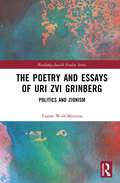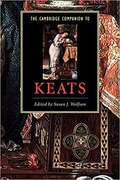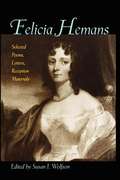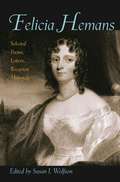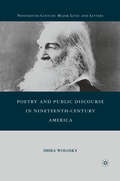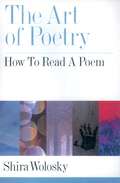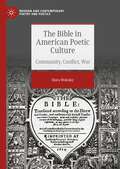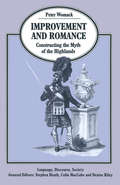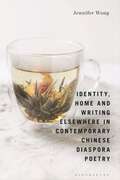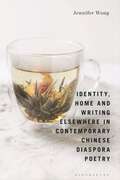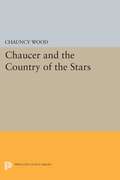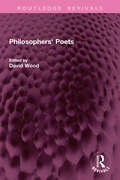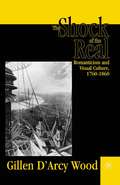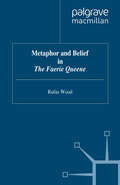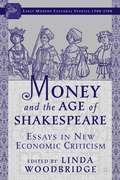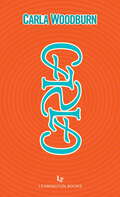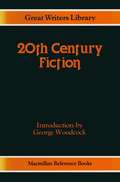- Table View
- List View
The Poetry and Essays of Uri Zvi Grinberg: Politics and Zionism (ISSN)
by Tamar Wolf-MonzonThis book focuses on the complex network of relationships between the poet Uri Zvi Grinberg and the Labor Movement in Mandate Palestine from 1923 to 1937.Making use of letters found in the Uri Zvi Grinberg Archive at the National Library of Israel (NLI), the author reconstructs the characteristics of Grinberg’s pioneer readership, attesting to their special relationship with his poetry. In the 1920s, it is argued, they considered Grinberg’s poetry an authentic expression of their complex spiritual world and especially of the reality of their lives. On his side, Grinberg accepted the pioneering ethos as the ideological basis of his works, becoming an outstanding poet of the Labor Movement. The chapters of this book track the various phases of Grinberg’s life and poetry, from his emigration to Palestine through to the 1930s, when he joined the Revisionist Movement and became increasingly ostracized from the Labor Movement. The story of Grinberg’s relations with the pioneers was emotionally charged—a mixture of enchantment and rejection, spiritual closeness and repulsion. Ultimately, this book analyzes the intensity of this connection and its many contradictory layers.This book will interest researchers in a range of fields, including Hebrew poetry and reception theory, as well as anyone interested in Israeli studies and the history of the Labor Movement in Palestine.
Open Book in Ways of Water
by Adam WolfondIn Open Book in Ways of Water, poet and artist Adam Wolfond explores the synaesthetic quality of autistic perception, the way in which water in its different materializations shapes and channels language. Building on notions such as “wetness,” “streams,” and “currents,” Wolfond constructs a linguistic universe in which writing and perception merge, move, and “pace to gether” – echoing both the togetherness of the senses and the gathering rhythms of water. Open Book in Ways of Water is as much a book of poetry and a book about poetry, a self-reflection in an endlessly moving and transforming element. As the author himself explains: Language is a way to understand each other but it is also reductive in the ways that it is abstracted and non-sensuous, and open writing as movement tends to be ignored as autistics are forced into neurotypical ways of seeing, and the thinking around artistic practices feels of a pace that intensifies the use of forms forming, and similarities with open processes are languaging the way of water, making language about artful relations with the more than human. Water is a game of ways and patterns that wave and ripple and can pull us under, the talk is about surfacing but languaging is about feeling, moving the ways that it makes are having variances moving the thresholds in thinking feeling of a rally that comes from cutting the grammars out and that is the way of perception that is cut by grammar and people need art to dance this dance of relation. A man of autism answers the ways of the body much of the time and that means my body rallies the artful atmospheres that are dancing me and the real feeling can dance the atmospheres as my body presence and pace shifts other bodies to be free. Having a ticcing body is making the dance about disorder but really it is about a different and diverse way of languaging with many feelings and bathing and immersing and I don’t have any other way.
The Poetics of Space and Place in Scottish Literature (Geocriticism and Spatial Literary Studies)
by Julian Wolfreys Monika SzubaThis book addresses the poetics of space and place in Scottish literature. Focusing chiefly on twentieth- and twenty-first century texts, with acknowledgement of historical and philosophical contexts, the essays address representation, narrative form, the work of the poetic, perception and experience. Major genres and forms are discussed, and authors as diverse as George Mackay Brown, Kathleen Jamie, Ken McLeod and Kei Miller are presented through theoretically informed, historically contextualized close readings. Additionally considering the role of dialect and region in the poetry and fiction of modern Scotland, the volume argues for an appreciation of the cultural diversity of Scottish writers while highlighting the overarching presence of a connection between self and world, subject and place within Scottish literature.
The Cambridge Companion To Keats (Cambridge Companions To Literature Ser.the\cambridge Companions To Literature)
by Susan J. WolfsonIn The Cambridge Companion to Keats, leading scholars discuss Keats's work in several fascinating contexts: literary history and key predecessors; Keats's life in London's intellectual, aesthetic and literary culture; the relation of his poetry to the visual arts; the critical traditions and theoretical contexts within which Keats's life and achievements have been assessed. These specially commissioned essays examine Keats's specific poetic endeavours, his striking way with language, and his lively letters as well as his engagement with contemporary cultures and literary traditions, his place in criticism, from his day to ours, including the challenge he poses to gender criticism. The contributions are sophisticated but accessible, challenging but lucid, and are complemented by an introduction to Keats's life, a chronology, a descriptive list of contemporary people and periodicals, a source-reference for famous phrases and ideas articulated in Keats's letters, a glossary of literary terms and a guide to further reading.
Felicia Hemans: Selected Poems, Letters, Reception Materials
by Susan J. WolfsonThe first standard edition of the writings of Felicia Hemans (1793-1835), this volume marks a revival of interest in, and a new critical appreciation of, one of the most important literary figures of the early nineteenth century. A best-selling poet in England and America, Felicia Hemans was regarded as leading female poet in her day, celebrated as the epitome of national "feminine" values. However, this same narrow perception of her work eventually relegated Hemans to an obscurity lightened occasionally by parody and a sentimental enthusiasm for poems such as "The Landing of the Pilgrim Fathers" and "Casabianca." Only now is Hemans's work being rediscovered and reconsidered--for the complexity of its social and political vision, but also for its sounding of dissonances in nineteenth-century cultural ideals, and for its recasting of the traditional canon of male "Romantics."Offering readers a firsthand acquaintance with the remarkable range of Hemans's writing, this volume includes five major works in their entirety, along with a much-admired aggregate, Records of Woman. Hemans's letters, many published here for the first time, reflect her views of her contemporaries, her work, her negotiations with publishers, and her emerging celebrity, while reviews and letters from others--including Lord Byron, Walter Scott, and the Wordsworths--tell the story of Hemans's reception in her time. An introduction by editor Susan Wolfson puts these writings, as well as Hemans's life and work, into much-needed perspective for the contemporary reader.
Felicia Hemans: Selected Poems, Letters, Reception Materials
by Susan J. WolfsonThe first standard edition of the writings of Felicia Hemans (1793-1835), this volume marks a revival of interest in, and a new critical appreciation of, one of the most important literary figures of the early nineteenth century. A best-selling poet in England and America, Felicia Hemans was regarded as leading female poet in her day, celebrated as the epitome of national "feminine" values. However, this same narrow perception of her work eventually relegated Hemans to an obscurity lightened occasionally by parody and a sentimental enthusiasm for poems such as "The Landing of the Pilgrim Fathers" and "Casabianca." Only now is Hemans's work being rediscovered and reconsidered--for the complexity of its social and political vision, but also for its sounding of dissonances in nineteenth-century cultural ideals, and for its recasting of the traditional canon of male "Romantics."Offering readers a firsthand acquaintance with the remarkable range of Hemans's writing, this volume includes five major works in their entirety, along with a much-admired aggregate, Records of Woman. Hemans's letters, many published here for the first time, reflect her views of her contemporaries, her work, her negotiations with publishers, and her emerging celebrity, while reviews and letters from others--including Lord Byron, Walter Scott, and the Wordsworths--tell the story of Hemans's reception in her time. An introduction by editor Susan Wolfson puts these writings, as well as Hemans's life and work, into much-needed perspective for the contemporary reader.
Poetry and Public Discourse in Nineteenth-Century America (Nineteenth-Century Major Lives and Letters)
by S. WoloskyPoetry and Public Discourse in Nineteenth-Century America explores nineteenth-century poetry as it addresses and engages in the major concerns of American cultural life. Focusing on gender, biblical politics, Revolutionary discourses and racial, sectional, and religious identities, this book reveals how these issues contended and negotiated with each other in the shaping of a pluralist democratic polity. Nineteenth-century American poetry, far from being the self-reflective art object of twentieth-century aesthetic theory, offered a rhetorical arena in which civic, economic, and religious trends intersected with each other in mutual definition and investigation. With a deft hand, Shira Wolosky demonstrates the ways in which poetry was a core impulse in the formation of American identity and cultural definition.
The Art of Poetry: How to Read a Poem
by Shira WoloskyIn The Art of Poetry, Shira Wolosky provides a dazzling introduction to an art whose emphasis on verbal music, wordplay, and dodging the merely literal makes it at once the most beguiling and most challenging of literary forms. A uniquely comprehensive, step-by-step introduction to poetic form, The Art of Poetry moves progressively from smaller units such as the word, line, and image, to larger features such as verse forms and voice. In fourteen engaging, beautifully written chapters, Wolosky explores in depth how poetry does what it does while offering brilliant readings of some of the finest lyric poetry in the English and American traditions. Both readers new to poetry and poetry veterans will be moved and enlightened as Wolosky interprets work by William Shakespeare, John Donne, William Blake, William Wordsworth, Emily Dickinson, Robert Frost, Sylvia Plath, and others. The book includes a superb two-chapter discussion of the sonnet's form and history, and represents the first poetry guide to introduce gender as a basic element of analysis. In contrast to many existing guides, which focus on selected formal aspects like metrics or present definitions and examples in a handbook format, The Art of Poetry covers the full landscape of poetry's subtle art while showing readers how to comprehend a poetic text in all its dimensions. Other special features include Wolosky's consideration of historical background for the developments she discusses, and the way her book is designed to acquaint or reacquaint readers with the core of the lyric tradition in English. Lively, accessible, and original, The Art of Poetry will be a rich source of inspiration for students, general readers, and those who teach poetry.
The Art of Poetry: How to Read a Poem
by Shira WoloskyIn The Art of Poetry, Shira Wolosky provides a dazzling introduction to an art whose emphasis on verbal music, wordplay, and dodging the merely literal makes it at once the most beguiling and most challenging of literary forms. A uniquely comprehensive, step-by-step introduction to poetic form, The Art of Poetry moves progressively from smaller units such as the word, line, and image, to larger features such as verse forms and voice. In fourteen engaging, beautifully written chapters, Wolosky explores in depth how poetry does what it does while offering brilliant readings of some of the finest lyric poetry in the English and American traditions. Both readers new to poetry and poetry veterans will be moved and enlightened as Wolosky interprets work by William Shakespeare, John Donne, William Blake, William Wordsworth, Emily Dickinson, Robert Frost, Sylvia Plath, and others. The book includes a superb two-chapter discussion of the sonnet's form and history, and represents the first poetry guide to introduce gender as a basic element of analysis. In contrast to many existing guides, which focus on selected formal aspects like metrics or present definitions and examples in a handbook format, The Art of Poetry covers the full landscape of poetry's subtle art while showing readers how to comprehend a poetic text in all its dimensions. Other special features include Wolosky's consideration of historical background for the developments she discusses, and the way her book is designed to acquaint or reacquaint readers with the core of the lyric tradition in English. Lively, accessible, and original, The Art of Poetry will be a rich source of inspiration for students, general readers, and those who teach poetry.
The Bible in American Poetic Culture: Community, Conflict, War (Modern and Contemporary Poetry and Poetics)
by Shira WoloskyAlthough the Bible is the foundation of American poetic tradition, there is no study of the Bible as an ongoing force in American poetry. Not only a source of imagery, allusion, rhythm and style, the Bible is central to how poetry has both shaped and been shaped by American civic, political, and social history, including issues of ethnicity, race and gender. Through poetry core issues of the Bible in American culture emerge in a new light. What defines America as a nation? What are its historical, political and religious meanings and direction? Vitally, how is it that the Bible is at once a shared common text, binding community, and yet was throughout American culture also contested, disputed, and politicized as a weapon of war? This study begins with the Puritans, and goes on to examine poetry of the Revolutionary and Civil Wars, as well as claims and counterclaims in abolition, slavery, and women’s rights. In doing so it treats both popular and major writers, including Edward Taylor, Frances Harper, Emerson, Whitman, Dickinson, Moore and Gwendoln Brooks, concluding with Amanda Gorman.
Improvement and Romance: Constructing the Myth of the Highlands (Language, Discourse, Society)
by Peter WomackAn attempt to trace the origins of the romantic image of the Highlands, by examining the economic, military and ideological circumstances of the region's subjugation by the British state. It combines literary criticism and cultural history to produce a case study of the making of the myth.
Identity, Home and Writing Elsewhere in Contemporary Chinese Diaspora Poetry
by Jennifer WongAn exploration of the burgeoning field of Anglophone Asian diaspora poetry, this book draws on the thematic concerns of Hong Kong, Asian-American and British Asian poets from the wider Chinese or East Asian diasporic culture to offer a transnational understanding of the complex notions of home, displacement and race in a globalised world.Located within current discourse surrounding Asian poetry, postcolonial and migrant writing, and bridging the fields of literary and cultural criticism with author interviews, this book provides close readings on established and emerging Chinese diasporic poets' work by incorporating the writers' own reflections on their craft through interviews with some of those featured. In doing so, Jennifer Wong explores the usefulness and limitations of existing labels and categories in reading the works of selected poets from specific racial, socio-cultural, linguistic environments and gender backgrounds, including Bei Dao, Li-Young Lee, Marilyn Chin, Hannah Lowe and Sarah Howe, Nina Mingya Powles and Mary Jean Chan. Incorporating scholarship from both the East and the West, Wong demonstrates how these poets' experimentation with poetic language and forms serve to challenge the changing notions of homeland, family, history and identity, offering new evaluations of contemporary diasporic voices.
Identity, Home and Writing Elsewhere in Contemporary Chinese Diaspora Poetry
by Jennifer WongAn exploration of the burgeoning field of Anglophone Asian diaspora poetry, this book draws on the thematic concerns of Hong Kong, Asian-American and British Asian poets from the wider Chinese or East Asian diasporic culture to offer a transnational understanding of the complex notions of home, displacement and race in a globalised world.Located within current discourse surrounding Asian poetry, postcolonial and migrant writing, and bridging the fields of literary and cultural criticism with author interviews, this book provides close readings on established and emerging Chinese diasporic poets' work by incorporating the writers' own reflections on their craft through interviews with some of those featured. In doing so, Jennifer Wong explores the usefulness and limitations of existing labels and categories in reading the works of selected poets from specific racial, socio-cultural, linguistic environments and gender backgrounds, including Bei Dao, Li-Young Lee, Marilyn Chin, Hannah Lowe and Sarah Howe, Nina Mingya Powles and Mary Jean Chan. Incorporating scholarship from both the East and the West, Wong demonstrates how these poets' experimentation with poetic language and forms serve to challenge the changing notions of homeland, family, history and identity, offering new evaluations of contemporary diasporic voices.
Chaucer and the Country of the Stars: Poetic Uses of Astrological Imagery (PDF)
by Chauncy WoodProfessor Wood examines in detail the astrological references in The Canterbury Tales, Troilus and Criseyde, and The Complaint of Mars, using mediaeval source materials not only to elucidate the technicalities of the imagery but also to analyze its poetic function.Originally published in 1970.The Princeton Legacy Library uses the latest print-on-demand technology to again make available previously out-of-print books from the distinguished backlist of Princeton University Press. These editions preserve the original texts of these important books while presenting them in durable paperback and hardcover editions. The goal of the Princeton Legacy Library is to vastly increase access to the rich scholarly heritage found in the thousands of books published by Princeton University Press since its founding in 1905.
Philosophers' Poets (Routledge Revivals)
by David WoodFirst published in 1990, Philosophers’ Poets is a collection of case studies of philosophers’ readings of poets and other distinctive writers. There are those, for example, who find in literary examples ways of exploring the concrete significance of philosophical assertions or distinctions. Others find in poetic discourse linguistic resources simply not available to philosophy, yet of vital importance to it. This is particularly true of philosophers of the limit, such as Heidegger, Derrida, Levinas and Adorno, for whom the very possibility of philosophy was in question. Despite the diversity of subjects covered, the collection maintains an integrity and identity. Above all, it shows how contemporary Continental philosophy raises the issue of philosophy and literature anew in a way that is appealing and challenging.
The Shock of the Real: Romanticism and Visual Culture,1760-1860
by G. WoodAlready in the century before photography's emergence as a mass medium, a diverse popular visual culture had risen to challenge the British literary establishment. The bourgeois fashion for new visual media - from prints and illustrated books to theatrical spectacles and panoramas - rejected high. Romantic concepts of original genius and the sublime in favor of mass-produced images and the thrill of realistic effects. In response, the literary elite declared the new visual media an offense to Romantic idealism. 'Simulations of nature,' Coleridge declared, are 'loathsome' and 'disgusting.' The Shock of the Real offers a tour of Romantic visual culture, from the West End stage to the tourist-filled Scottish Highlands, from the panoramas of Leicester Square to the photography studios of Second Empire Paris. But in presenting the relation between word and image in the late Georgian age as a form of culture war, the author also proposes an alternative account of Romantic aesthetic ideology - as a reaction not against the rationalism of the Enlightenment but against the visual media age being born.
On Empson
by Michael WoodFrom one of today's most distinguished critics, a beautifully written exploration of one of the twentieth century's most important literary criticsAre literary critics writers? As Michael Wood says, "Not all critics are writers—perhaps most of them are not—and some of them are better when they don't try to be." The British critic and poet William Empson (1906–84), one of the most important and influential critics of the twentieth century, was an exception—a critic who was not only a writer but also a great one. In this brief book, Wood, himself one of the most gifted writers among contemporary critics, explores Empson as a writer, a distinguished poet whose criticism is a brilliant literary performance—and proof that the act of reading can be an unforgettable adventure.Drawing out the singularity and strength of Empson's writing, including its unfailing wit, Wood traces the connections between Empson's poetry and criticism from his first and best-known critical works, Seven Types of Ambiguity and Some Versions of Pastoral, to later books such as Milton's God and The Structure of Complex Words. Wood shows why this pioneer of close reading was both more and less than the inventor of New Criticism—more because he was the greatest English critic since Coleridge, and didn't belong to any school; and less because he had severe differences with many contemporary critics, especially those who dismissed the importance of an author's intentions.Beautifully written and rich with insight, On Empson is an elegant introduction to a unique writer for whom literature was a nonstop form of living.
On Empson
by Michael WoodFrom one of today's most distinguished critics, a beautifully written exploration of one of the twentieth century's most important literary criticsAre literary critics writers? As Michael Wood says, "Not all critics are writers—perhaps most of them are not—and some of them are better when they don't try to be." The British critic and poet William Empson (1906–84), one of the most important and influential critics of the twentieth century, was an exception—a critic who was not only a writer but also a great one. In this brief book, Wood, himself one of the most gifted writers among contemporary critics, explores Empson as a writer, a distinguished poet whose criticism is a brilliant literary performance—and proof that the act of reading can be an unforgettable adventure.Drawing out the singularity and strength of Empson's writing, including its unfailing wit, Wood traces the connections between Empson's poetry and criticism from his first and best-known critical works, Seven Types of Ambiguity and Some Versions of Pastoral, to later books such as Milton's God and The Structure of Complex Words. Wood shows why this pioneer of close reading was both more and less than the inventor of New Criticism—more because he was the greatest English critic since Coleridge, and didn't belong to any school; and less because he had severe differences with many contemporary critics, especially those who dismissed the importance of an author's intentions.Beautifully written and rich with insight, On Empson is an elegant introduction to a unique writer for whom literature was a nonstop form of living.
Sidney’s Arcadia and the conflicts of virtue (G - Reference,information And Interdisciplinary Subjects Ser.)
by Richard James WoodWood reads Philip Sidney’s New Arcadia in the light of the ethos known as Philippism after the followers of Philip Melanchthon the Protestant theologian. He employs a critical paradigm previously used to discuss Sidney’s Defence of Poesy and narrows the gap that critics have found between Sidney’s theory and literary practice. This book is a valuable resource for scholars and researchers in the fields of literary and religious studies.Various strands of philosophical, political and theological thought are accommodated within the New Arcadia, which conforms to the kind of literature praised by Melanchthon for its examples of virtue. Employing the same philosophy, Sidney, in his letter to Queen Elizabeth and in his fiction, arrogates to himself the role of court counsellor. Robert Devereux also draws, Wood argues, on the optimistic and conciliatory philosophy signified by Sidney’s New Arcadia.
Sidney’s Arcadia and the conflicts of virtue
by Richard James WoodWood reads Philip Sidney’s New Arcadia in the light of the ethos known as Philippism after the followers of Philip Melanchthon the Protestant theologian. He employs a critical paradigm previously used to discuss Sidney’s Defence of Poesy and narrows the gap that critics have found between Sidney’s theory and literary practice. This book is a valuable resource for scholars and researchers in the fields of literary and religious studies. Various strands of philosophical, political and theological thought are accommodated within the New Arcadia, which conforms to the kind of literature praised by Melanchthon for its examples of virtue. Employing the same philosophy, Sidney, in his letter to Queen Elizabeth and in his fiction, arrogates to himself the role of court counsellor. Robert Devereux also draws, Wood argues, on the optimistic and conciliatory philosophy signified by Sidney’s New Arcadia.
Metaphor and Belief in The Faerie Queene
by Rufus WoodRufus Wood contextualizes his study of The Faerie Queene through an initial discussion of attitudes towards metaphor expressed in Elizabethan poetry. He reveals how Elizabethan writers voice a commitment to metaphor as a means of discovering and exploring their world and shows how the concept of a metaphoric principle of structure underlying Elizabethan poetics generates an exciting interpretation of The Faerie Queene. The debate which emerges concerning the use and abuse of metaphor in allegorical poetry provides a valuable contribution to the field of Spenser studies in particular and Renaissance literature in general.
Robert Browning: A Literary Life (Literary Lives)
by S. WoodBrowning both denied and affirmed the value of biography for an understanding of literature. This book narrates the development of his controversial creative life through responses to his work by five key nineteenth-century figures: John Stuart Mill, William Charles Macready, Thomas Carlyle, John Ruskin and Matthew Arnold. It also relates Browning's sense of literary vocation to Victorian publishing. Browning emerges as a writer vividly engaged with contemporary assumptions, yet deeply aware of the unaccountability of writing.
Money and the Age of Shakespeare: Essays in New Economic Criticism (Early Modern Cultural Studies 1500–1700)
by L. WoodbridgeIn this collection literary scholars, theorists and historians deploy new economic techniques to illuminate English Renaissance literature in fresh ways. Contributors variously explore poetry's precarious perch between gift and commodity; the longing for family in The Comedy of Errors as symbolically expressing the alienating pressures of mercantilism; Measure for Measure 's representation of singlewomen and the feminization of poverty; the collision between two views of money in a possible collaboration between Shakespeare and Middleton; the cultural spread of an accounting mentality and quantitative thinking; and money as it crosses the frontier between price and pricelessness, and from early bodily-injury insurance schemes to The Merchant of Venice .
Carla
by Carla WoodburnIn this book you will find a collection of Carla's poetry written over a lifetime up until now. This book of poetry has been a labour of love. The collection is an expression of love, lust, reality and surrealism, written from the heart. The poems are a direct result of the way Carla Woodburn views life and expresses the situations around her. Inspiration is taken from everyday occurrences and Carla likes to think she's used alchemy to transform these situations into a beautiful collection of poetry hailing from Scotland. A joyful and funny collection of poetry that can be enjoyed by adults and poetry lovers around the globe. This collection is a lifetime’s work of Carla's and is lovingly dedicated to Carla's family.
